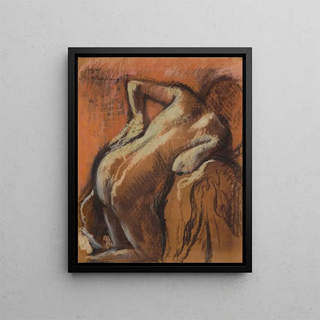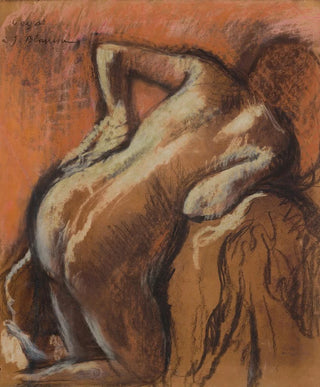Art print | After the bath woman drying herself (Case Conflict) - Edgar Degas


View from behind

Frame (optional)
In the fascinating world of impressionist art, the art print "Après le bain femme s'essuyant" by Edgar Degas stands out for its ability to capture human intimacy and vulnerability. This depiction of a woman drying herself after a bath evokes a scene that is both everyday and deeply personal. Degas, master of observation, manages to immortalize a fleeting moment, transforming a simple action into an art print imbued with poetry. The light, shapes, and colors intertwine to create an atmosphere where the viewer is invited to contemplate the beauty of ordinary life. This piece, through its delicacy and realism, embodies the very essence of impressionism, while revealing the artist's deeper concerns about the human condition.
Style and uniqueness of the work
Edgar Degas's style is characterized by a unique approach to composition and color. In "Après le bain femme s'essuyant," he uses fluid brushstrokes and soft hues to evoke warmth and intimacy in the private space. The posture of the woman, both natural and elegant, demonstrates Degas's ability to capture moments of everyday life with rare sensitivity. The way he plays with light and shadow creates a depth that transcends mere representation. The art print does not just show a woman drying herself; it invites the viewer to feel the warmth of the water, the softness of the towel, and the tranquility of the moment. This ability to merge movement and light makes Degas an innovator in the field of art, redefining the conventions of his time.
The artist and his influence
Edgar Degas, born in 1834, is often considered one of the pioneers of impressionism, although he always defined himself as a realist. His work explores various themes, ranging from dance to urban life, including scenes of everyday life. Degas's influence on modern art is undeniable. His ability to capture fleeting moments and his interest in representing the human figure have

Matte finish

View from behind

Frame (optional)
In the fascinating world of impressionist art, the art print "Après le bain femme s'essuyant" by Edgar Degas stands out for its ability to capture human intimacy and vulnerability. This depiction of a woman drying herself after a bath evokes a scene that is both everyday and deeply personal. Degas, master of observation, manages to immortalize a fleeting moment, transforming a simple action into an art print imbued with poetry. The light, shapes, and colors intertwine to create an atmosphere where the viewer is invited to contemplate the beauty of ordinary life. This piece, through its delicacy and realism, embodies the very essence of impressionism, while revealing the artist's deeper concerns about the human condition.
Style and uniqueness of the work
Edgar Degas's style is characterized by a unique approach to composition and color. In "Après le bain femme s'essuyant," he uses fluid brushstrokes and soft hues to evoke warmth and intimacy in the private space. The posture of the woman, both natural and elegant, demonstrates Degas's ability to capture moments of everyday life with rare sensitivity. The way he plays with light and shadow creates a depth that transcends mere representation. The art print does not just show a woman drying herself; it invites the viewer to feel the warmth of the water, the softness of the towel, and the tranquility of the moment. This ability to merge movement and light makes Degas an innovator in the field of art, redefining the conventions of his time.
The artist and his influence
Edgar Degas, born in 1834, is often considered one of the pioneers of impressionism, although he always defined himself as a realist. His work explores various themes, ranging from dance to urban life, including scenes of everyday life. Degas's influence on modern art is undeniable. His ability to capture fleeting moments and his interest in representing the human figure have






